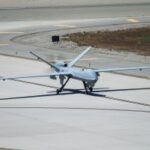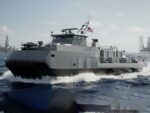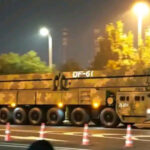The United States Army has deployed its new Typhon Mid-Range Capability (MRC) missile system to Japan for the first time—a landmark move that significantly alters the strategic landscape of the Indo-Pacific. The deployment introduces land-based Tomahawk and SM-6 missiles into a region increasingly defined by long-range precision fires and anti-access/area denial (A2/AD) challenges posed by China.
Typhon System Overview: A Modular Mid-Range Strike Platform
The Typhon system—also known as the Mid-Range Capability (MRC)—is a ground-based launcher developed by Lockheed Martin under an accelerated timeline following the 2019 U.S. withdrawal from the Intermediate-Range Nuclear Forces (INF) Treaty. It is designed to fill the range gap between the Precision Strike Missile (PrSM) (~500 km) and longer-range strategic assets like air-launched cruise missiles or ballistic missiles.
Typhon integrates two proven naval missiles into a mobile land-based platform:
- Tomahawk Land Attack Missile (TLAM): Subsonic cruise missile with ranges exceeding 1,600 km; capable of striking fixed targets with high precision.
- SM-6 Dual I/II: A versatile missile capable of surface-to-air interception and offensive anti-surface or land attack missions at ranges up to ~370 km depending on variant and profile.
The launcher is mounted on an M870 trailer pulled by an M983A4 tractor truck. The fire control system is based on software adapted from the Navy’s Aegis Combat System and employs a modular open systems architecture for future upgrades. The entire battery includes command vehicles, transporter erector launchers (TELs), support vehicles, and logistics elements.
Deployment Details: First Forward Stationing in Japan
According to official statements from U.S. Indo-Pacific Command (INDOPACOM) and corroborated by Japanese defense sources, elements of a U.S. Army Multi-Domain Task Force have deployed one Typhon battery to an undisclosed location in Japan as of early September 2025. This marks the first-ever overseas operational deployment of the system since its delivery to U.S. forces in late 2023.
This forward deployment follows bilateral agreements made during recent U.S.-Japan defense consultations aimed at bolstering integrated deterrence against regional threats. While neither side has disclosed exact basing details due to operational security concerns, Japanese media reports suggest presence on Kyushu or Okinawa—locations within range of key Chinese military infrastructure in the East China Sea region.
Strategic Implications for Indo-Pacific Deterrence
The introduction of Typhon into theater represents a major evolution in U.S. force posture in Asia:
- Counter-A2/AD Tool: By deploying long-range conventional strike capabilities on mobile land platforms, Typhon complicates Chinese targeting calculus across maritime domains where Beijing has invested heavily in anti-access systems such as DF-21D “carrier killer” ballistic missiles.
- Distributed Fires Doctrine: It supports emerging U.S. concepts like Joint Fires Network and Joint All-Domain Command and Control (JADC2), enabling multi-domain precision effects without relying solely on vulnerable fixed bases or carrier groups.
- Bilateral Integration: The deployment enhances interoperability with Japanese Self Defense Forces’ sensors and C4ISR networks under evolving frameworks like “Integrated Air and Missile Defense” (IAMD).
This move also signals that Washington is willing to leverage post-INF flexibility to counterbalance growing Chinese missile inventories—especially given China’s estimated arsenal of over 1,000 ground-launched intermediate-range missiles not constrained by any arms control treaty.
Development Timeline and Testing Milestones
The Typhon program was initiated under Project Convergence and Rapid Capabilities initiatives following congressional funding approval in FY2020. Key milestones include:
- Q4 2020: Contract awarded to Lockheed Martin Missiles & Fire Control for prototype development.
- Dec 2021–Oct 2022: Successful live-fire tests at White Sands Missile Range validating both Tomahawk and SM-6 integration onto ground launchers.
- Q4 2023: First battery delivered to I Corps’ Multi-Domain Task Force at Joint Base Lewis-McChord.
The program achieved Initial Operational Capability (IOC) ahead of schedule, reflecting urgency driven by Pacific theater requirements. Notably, it leverages existing Navy munitions stockpiles rather than requiring new missile development—a key factor enabling rapid fielding under budget constraints (~$400 million initial program cost).
A Regional Arms Race? Reactions from China and Allies
The People’s Republic of China has condemned the deployment as destabilizing, accusing Washington of militarizing Asia through provocative forward basing strategies. Chinese analysts have warned that such deployments could trigger reciprocal moves including enhanced PLA Rocket Force activity near Taiwan or expanded DF-series deployments along coastal provinces.
In contrast, regional allies such as Australia and South Korea have expressed support for enhanced U.S.-Japan deterrence cooperation. Tokyo’s Ministry of Defense emphasized that hosting such systems aligns with Japan’s revised National Security Strategy calling for “counterstrike capabilities” amid rising regional tensions post-Russia’s invasion of Ukraine.
This development also raises questions about future proliferation of similar systems among allies under frameworks like AUKUS Pillar II or Foreign Military Sales pathways—particularly if exportable variants emerge using different COTS components or reduced-range configurations compliant with MTCR guidelines.
Future Outlook: Expansion Beyond Japan?
The current deployment may be just the beginning of broader regional integration plans involving mobile long-range fires across multiple allied territories including Guam, Philippines (under EDCA sites), Australia’s Northern Territory, or even rotational basing models akin to HIMARS deployments seen during Pacific Pathways exercises.
The Army’s Long Range Fires Cross Functional Team continues exploring enhancements such as integration with hypersonic glide vehicles under programs like Dark Eagle LRHW (~2775 km range), which could complement Typhon’s mid-tier role within layered strike architectures across INDOPACOM Area Of Responsibility (AOR).
If successful operationally—and politically—the Typhon deployment may become a template for future land-based deterrent postures worldwide amid growing demand for survivable non-nuclear precision strike capabilities outside traditional air/naval platforms.









